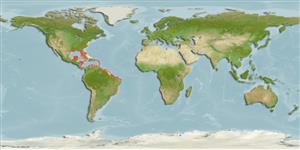Preferred temperature (Ref.
115969): 23.3 - 28.1, mean 27.2 (based on 912 cells).
Phylogenetic diversity index (Ref.
82804): PD
50 = 0.5000 [Uniqueness, from 0.5 = low to 2.0 = high].
Bayesian length-weight: a=0.01479 (0.01247 - 0.01755), b=2.99 (2.95 - 3.03), in cm Total Length, based on LWR estimates for this species (Ref.
93245).
Nível Trófico (Ref.
69278): 4.4 ±0.0 se; based on diet studies.
Resiliência (Ref.
120179): Médio, tempo mínimo de duplicação da população 1,4 - 4,4 anos (K=0.18-0.35; tmax=9; Fec=29,000).
Fishing Vulnerability (Ref.
59153): Moderate to high vulnerability (50 of 100).
